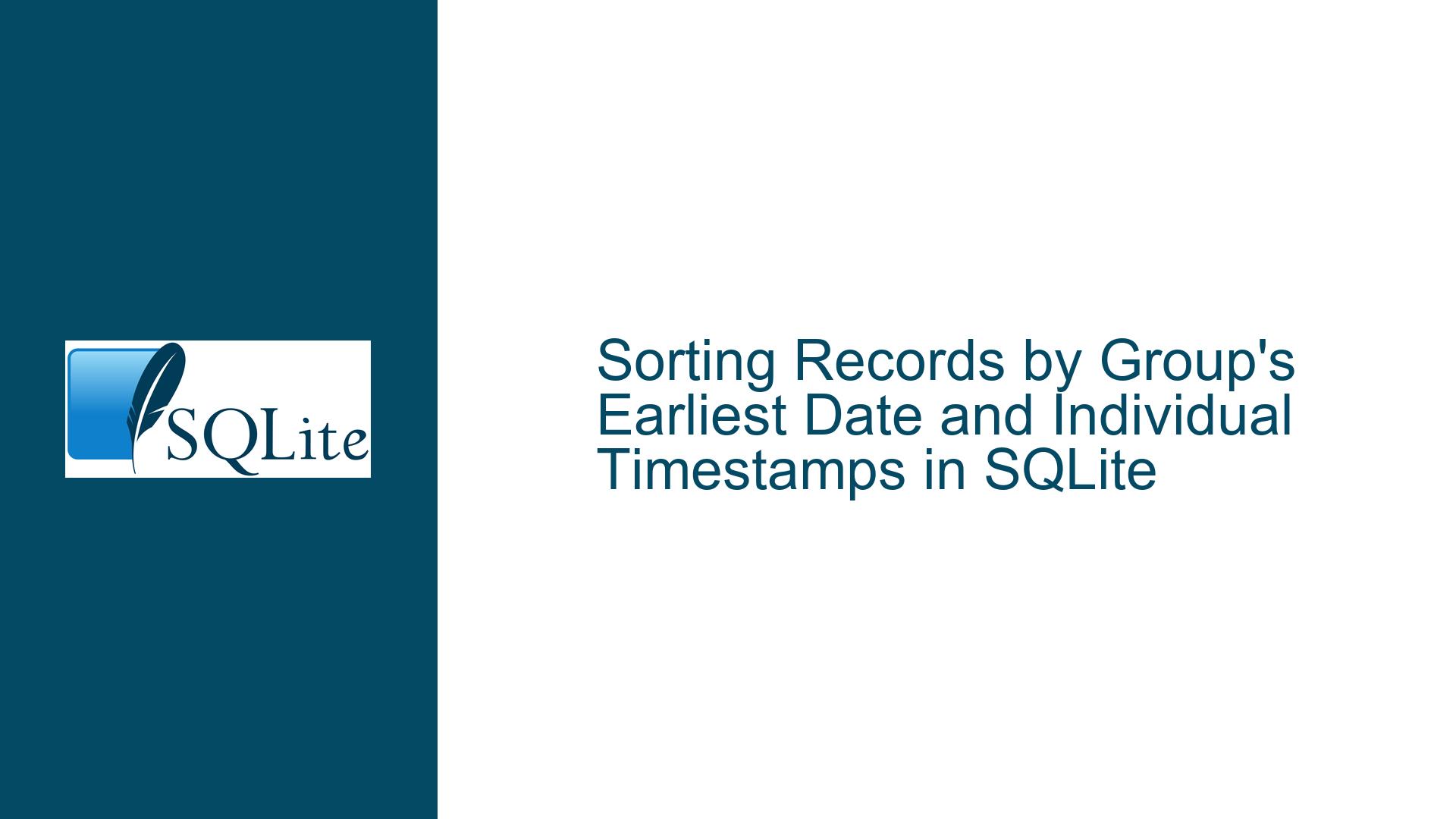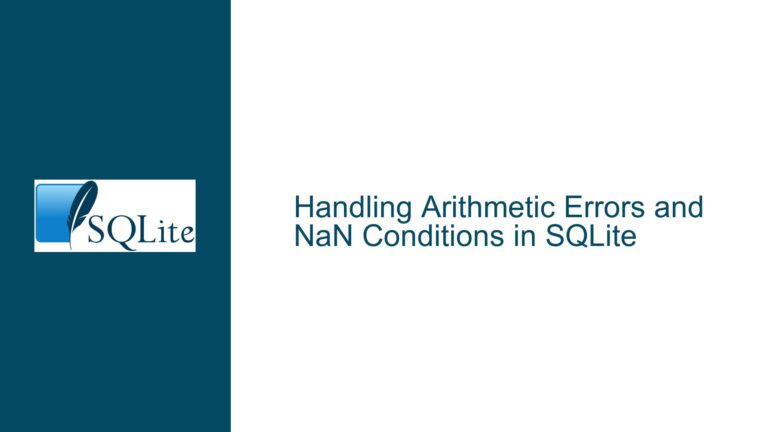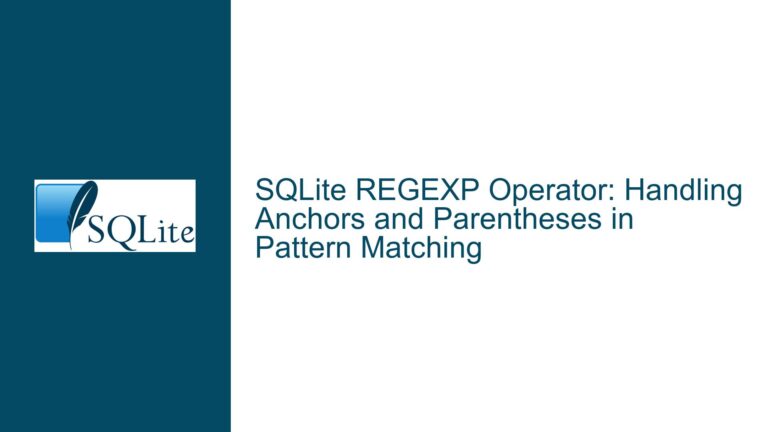Sorting Records by Group’s Earliest Date and Individual Timestamps in SQLite
Understanding the Requirement for Multi-Level Chronological Group Sorting
The core challenge involves ordering records in a table based on two distinct chronological criteria:
- Group-level priority determined by the earliest timestamp (minimum "Started" value) associated with each "ID"
- Intra-group ordering where all records sharing the same "ID" are sorted by their individual "Started" timestamps
This requires preserving the natural sequence of events within each ID group while establishing global ordering between groups based on their initial occurrence. The dataset exhibits these characteristics:
- Multiple entries per "ID" with varying "Started" timestamps
- IDs must be ordered based on their first observed "Started" value
- All records for a given ID must appear contiguously in results
- Secondary sorting within each ID group uses the "Started" column
Sample data demonstrates that IDs like "VbR7aK4ENK" (earliest group starting 2023-02-03) should appear before "fpnct7eR5o" (starting 2023-02-03 13:09:03), followed by "BcdMhdQf5L" (starting 2023-02-06). Each ID’s internal records must then sort by their "Started" values. Common failure modes include:
- Partial grouping where only one record per ID appears
- Interleaving of IDs due to direct sorting on "Started" without group prioritization
- Incorrect intra-group ordering from missing secondary sort criteria
Key Obstacles in Achieving Correct Hierarchical Temporal Sorting
1. Premature Collapse of Group Records via Basic Aggregation
Using a naive GROUP BY ID with MIN(Started) collapses all ID records into a single row, losing individual entries. This occurs when the query doesn’t join aggregated group metadata back to original records.
2. Absence of Common Table Expression (CTE) Support in Legacy SQLite
SQLite versions prior to 3.8.3 (2014-02-03) lack WITH clause support for CTEs. Queries attempting to create temporary named result sets for group minima will fail with syntax errors, blocking a straightforward implementation.
3. Implicit vs Explicit Join Semantics in Composite Queries
When combining aggregated group data with original records, improper join conditions may:
- Exclude relevant records through overly strict
ONclauses - Duplicate entries via Cartesian products from missing join predicates
- Misalign group metadata with individual rows
4. Sorting Precedence and Column Ambiguity in Compound Queries
Omitting the group’s minimum "Started" value from the ORDER BY clause leads to interleaved IDs. Similarly, failing to include both the group’s base timestamp and individual record timestamps in sort criteria disrupts the required hierarchy.
5. Indexing Strategy for Temporal Grouping Performance
Without appropriate indexes on "ID" and "Started" columns, subqueries calculating group minima may resort to full table scans, causing significant performance degradation on large datasets.
Comprehensive Methodology for Implementing Hierarchical Temporal Sorting
Phase 1: Establish Group-Level Temporal Metadata via Subquery
Create a derived table containing each ID’s initial occurrence timestamp using a subquery:
SELECT ID, MIN(Started) AS FirstStarted
FROM netlog
GROUP BY ID
This calculates the earliest "Started" value per ID, forming the foundation for group ordering.
Phase 2: Join Group Metadata with Original Records
Combine the group metadata with the base table using an INNER JOIN, ensuring all original records are preserved:
SELECT base.*
FROM netlog AS base
JOIN (
SELECT ID, MIN(Started) AS FirstStarted
FROM netlog
GROUP BY ID
) AS groups
ON base.ID = groups.ID
This associates every record with its group’s initial timestamp while retaining all individual rows.
Phase 3: Implement Multi-Level Sorting Criteria
Apply a two-tiered ORDER BY clause:
ORDER BY groups.FirstStarted, base.Started
This first sorts groups by their initial timestamp, then orders individual records within each group by their specific "Started" values.
Complete Query Assembly
Combining these components yields:
SELECT base.ID, base.Started, base.Result
FROM netlog AS base
JOIN (
SELECT ID, MIN(Started) AS FirstStarted
FROM netlog
GROUP BY ID
) AS groups
ON base.ID = groups.ID
ORDER BY groups.FirstStarted, base.Started;
Critical Implementation Considerations
Handling SQLite Version Limitations
For environments restricted to SQLite <3.8.3:
- Avoid CTEs: Use inline subqueries instead of
WITHclauses - Verify Join Syntax: Use explicit
JOINoperators rather than comma-separated tables - Test Index Usage: Ensure subqueries leverage indexes via
EXPLAIN QUERY PLAN
Index Optimization Strategy
Create a composite index to accelerate both group minima calculation and record sorting:
CREATE INDEX idx_netlog_id_started ON netlog(ID, Started);
This index:
- Allows efficient
MIN(Started)per ID via index-only scan - Optimizes sorting operations in both outer query and subquery
- Reduces disk I/O through covering index capabilities
Null Handling and Data Integrity
- Ensure "Started" column has
NOT NULLconstraint to prevent exclusion of records - Validate timestamp formats consistently use ISO 8601 (YYYY-MM-DD HH:MM:SS.SSS)
- Consider timezone implications if data spans multiple zones
Query Execution Plan Analysis
Use SQLite’s EXPLAIN QUERY PLAN to verify:
- Subquery utilizes covering index for
MIN(Started)aggregation - Join operation uses efficient index lookups rather than full scans
- Sorting occurs via index vs. temporary B-tree usage
Example analysis output:
QUERY PLAN
|--MATERIALIZE groups
| `--SCAN TABLE netlog USING INDEX idx_netlog_id_started
|--SCAN TABLE base
`--USE TEMP B-TREE FOR ORDER BY
Performance Tuning for Large Datasets
- Batch Processing: For tables exceeding memory, process in chunks using
LIMIT/OFFSETwith windowed ID ranges - Partial Indexes: If historical data is static, create indexes filtered by date ranges
- Write-Ahead Logging: Enable WAL mode to reduce locking during concurrent reads during analysis
Alternative Implementation Using Correlated Subquery
For environments where join performance is problematic:
SELECT ID, Started, Result
FROM netlog
ORDER BY (
SELECT MIN(Started)
FROM netlog AS g
WHERE g.ID = netlog.ID
), Started;
Tradeoffs:
- ✓ Simpler syntax
- ✗ Potentially slower due to repeated subquery execution per row
- ✗ May not use indexes efficiently
Migration Path to Modern SQLite Versions
- Python Environment: Update SQLite3 module using:
pip install pysqlite3-binaryThen override the standard library connection:
import pysqlite3 sys.modules['sqlite3'] = pysqlite3 - System-Level Upgrades:
- Linux:
sudo apt-get install sqlite3 - Windows: Download precompiled binaries from sqlite.org
- Linux:
- Verify Version Compatibility:
SELECT sqlite_version();
Edge Case Handling
Duplicate Minimum Timestamps
When multiple IDs share identical FirstStarted values, include the ID in the ORDER BY as tiebreaker:
ORDER BY groups.FirstStarted, base.ID, base.Started
Cross-Group Temporal Overlaps
If subsequent entries from one group fall between timestamps of another group’s records, the primary sort on FirstStarted ensures group contiguity regardless of individual timestamps.
Missing Records Post-Join
- Confirm
JOINusesINNER JOINrather thanLEFT JOINif retaining all base records is required - Check for trailing spaces or case mismatches in "ID" values between joined tables
Debugging Common Result Set Anomalies
Symptom: IDs Appear Only Once
Cause: Accidental use of GROUP BY in outer query instead of subquery
Fix: Ensure aggregation occurs only in the group metadata subquery
Symptom: Incorrect Group Order
Cause: Sorting on base.Started instead of groups.FirstStarted
Fix: Verify ORDER BY first references the grouped minimum
Symptom: Duplicate Rows
Cause: Cartesian product from omitted join condition
Fix: Confirm ON base.ID = groups.ID exists
Symptom: Slow Performance
Cause: Full table scans due to missing indexes
Fix: Create composite index on (ID, Started)
Final Production-Grade Implementation
-- Index optimization
CREATE INDEX IF NOT EXISTS idx_netlog_id_started ON netlog(ID, Started);
-- Verified query for SQLite >=3.7.17
SELECT
nl.ID AS "ID",
nl.Started AS "Started",
nl.Result AS "Result"
FROM
netlog nl
INNER JOIN (
SELECT
ID,
MIN(Started) AS GroupStart
FROM
netlog
GROUP BY
ID
) grp ON nl.ID = grp.ID
ORDER BY
grp.GroupStart ASC, -- Primary sort by group's first occurrence
nl.ID ASC, -- Tiebreaker for groups with same GroupStart
nl.Started ASC; -- Chronological sort within groups
This implementation:
- Leverages efficient index scans for both data retrieval and sorting
- Maintains all original records through proper join semantics
- Explicitly handles sorting edge cases
- Remains compatible with legacy SQLite versions
- Provides deterministic output ordering
Long-Term Maintenance Considerations
- Automated Version Checks: Embed SQLite version validation in application startup:
import sqlite3 if sqlite3.sqlite_version_info < (3, 8, 3): raise RuntimeError("SQLite 3.8.3+ required for CTE support") - Monitoring Index Fragmentation: Periodically
ANALYZEandREINDEXto maintain query performance - Query Plan Regression Testing: Store expected
EXPLAIN QUERY PLANoutputs as part of CI/CD pipelines - Data Lifecycle Management: Implement archival policies for old records to maintain sorting performance
- Alternate Storage Engines: For petabyte-scale data, consider hybrid approaches with recent SQLite versions’ features like BLOB streaming or virtual tables
By systematically addressing the interaction between group aggregation, join mechanics, and sorting precedence, this approach provides a robust solution for hierarchical temporal ordering in SQLite across various deployment environments.






